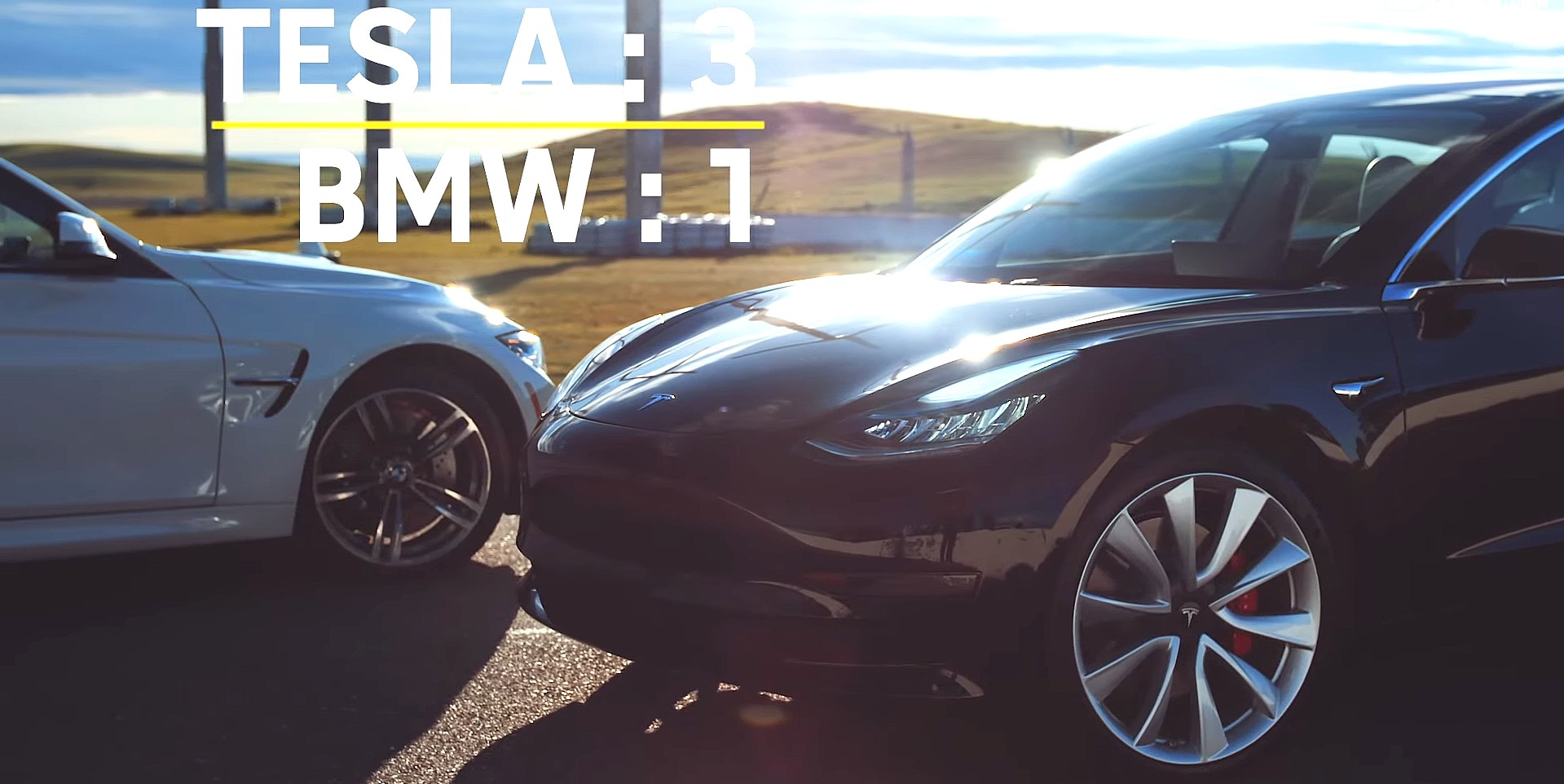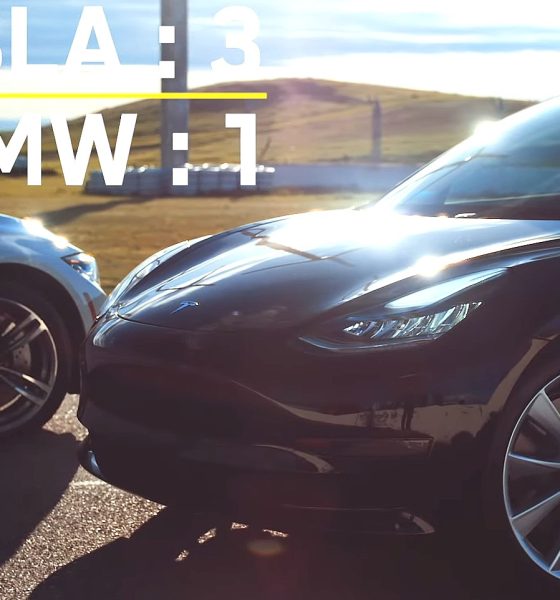

News
Watch Tesla’s Model 3 spank the BMW M3 in head-to-head track test (VIDEO)
Popular auto magazine Top Gear recently published its most daring cover in years, declaring in boldface lettering that “Electric Beats Petrol.” Two high-performance sedans dominated the cover: the Tesla Model 3 Performance and the BMW M3, both of which represent the best that their class of vehicles has to offer. The publication has now released footage of the two cars’ tests, showing, in their full electric vs. petrol glory, just how much the Model 3 practically spanked the BMW M3.
The recently uploaded video covered the four tests that the Model 3 Performance and the M3 were subjected to. Both vehicles were driven by veteran auto journalist Jack Rix (who admits that he is not a professional racing driver, thereby representing the majority of people who own the two high-performance sedans), who took the Model 3 and the M3 around the Thunderhill Raceway in Willows, CA. It should be noted that the BMW M3 that Top Gear utilized for its tests was not equipped with the Competition package, to make the prices of the two cars line up better.
The two vehicles being subjected to a classic quarter-mile drag race, a 0-100-0 mph brake test, a time attack challenge around the Thunderhill track, and a drifting test. The drag race between the Model 3 and the M3 was not even a competition, with the all-electric sedan leaving the internal combustion-powered BMW in the dust. The Model 3 Performance finished the drag race in 11.9 seconds at 112.6 mph, significantly faster than the BMW M3’s 119.1 mph and 12.6-second time. The 0-100-0 mph braking test ended in a similar fashion, with the Tesla Model 3 drawing blood once more with 13.1 seconds compared to the BMW M3’s 13.8 seconds.
The main event of the magazine’s test was a hot lap around Thunderhill. The Top Gear journalist utilized Track Mode for the Model 3, allowing him to maneuver the rather heavy vehicle around the race course’s corners. The Model 3 Performance ultimately completed a lap around the track in 1:34.07. The BMW M3 roared through the closed circuit, and though the vehicle weighed considerably less than the Model 3, the German high-performance sedan completed the lap in 1:35.96.
The BMW did shine against the Model 3 in Top Gear‘s drifting test, as the M3 was dubbed by the veteran journalist as the more fun car to throw around the track’s corners. Despite this win, the test still ended with the Tesla Model 3 getting three wins out of four against the BMW M3. In conclusion, the journalist notes that between the two vehicles, the Model 3 is superior in many fronts, though he would still take the BMW M3 around a track due to its nimble characteristics. Nevertheless, the Model 3’s capability to tear up a closed circuit and remain refined enough on the road is something that is remarkable.
While the conclusions of Top Gear‘s head-to-head test between the Tesla Model 3 Performance and the BMW M3 are bound to be polarizing, the all-electric sedan’s wins against the internal combustion champion stand as a pivotal moment for auto enthusiasts. Gone are the days when electric cars are slow and unattractive, and gone are the days when even premium EVs can’t even make it around a track without throttling their power. Tesla has leveled the playing field with the Model 3 Performance, and as these tests show, the plain superiority of electric propulsion is now starting to become quite evident.
Watch the Tesla Model 3 Performance and the BMW M3 battle it out in four tests in the video below.

News
Tesla FSD fleet is nearing 7 billion total miles, including 2.5 billion city miles
As can be seen on Tesla’s official FSD webpage, vehicles equipped with the system have now navigated over 6.99 billion miles.

Tesla’s Full Self-Driving (Supervised) fleet is closing in on almost 7 billion total miles driven, as per data posted by the company on its official FSD webpage.
These figures hint at the massive scale of data fueling Tesla’s rapid FSD improvements, which have been quite notable as of late.
FSD mileage milestones
As can be seen on Tesla’s official FSD webpage, vehicles equipped with the system have now navigated over 6.99 billion miles. Tesla owner and avid FSD tester Whole Mars Catalog also shared a screenshot indicating that from the nearly 7 billion miles traveled by the FSD fleet, more than 2.5 billion miles were driven inside cities.
City miles are particularly valuable for complex urban scenarios like unprotected turns, pedestrian interactions, and traffic lights. This is also the difference-maker for FSD, as only complex solutions, such as Waymo’s self-driving taxis, operate similarly on inner-city streets. And even then, incidents such as the San Francisco blackouts have proven challenging for sensor-rich vehicles like Waymos.
Tesla’s data edge
Tesla has a number of advantages in the autonomous vehicle sector, one of which is the size of its fleet and the number of vehicles training FSD on real-world roads. Tesla’s nearly 7 billion FSD miles then allow the company to roll out updates that make its vehicles behave like they are being driven by experienced drivers, even if they are operating on their own.
So notable are Tesla’s improvements to FSD that NVIDIA Director of Robotics Jim Fan, after experiencing FSD v14, noted that the system is the first AI that passes what he described as a “Physical Turing Test.”
“Despite knowing exactly how robot learning works, I still find it magical watching the steering wheel turn by itself. First it feels surreal, next it becomes routine. Then, like the smartphone, taking it away actively hurts. This is how humanity gets rewired and glued to god-like technologies,” Fan wrote in a post on X.
News
Tesla starts showing how FSD will change lives in Europe
Local officials tested the system on narrow country roads and were impressed by FSD’s smooth, human-like driving, with some calling the service a game-changer for everyday life in areas that are far from urban centers.

Tesla has launched Europe’s first public shuttle service using Full Self-Driving (Supervised) in the rural Eifelkreis Bitburg-Prüm region of Germany, demonstrating how the technology can restore independence and mobility for people who struggle with limited transport options.
Local officials tested the system on narrow country roads and were impressed by FSD’s smooth, human-like driving, with some calling the service a game-changer for everyday life in areas that are far from urban centers.
Officials see real impact on rural residents
Arzfeld Mayor Johannes Kuhl and District Administrator Andreas Kruppert personally tested the Tesla shuttle service. This allowed them to see just how well FSD navigated winding lanes and rural roads confidently. Kruppert said, “Autonomous driving sounds like science fiction to many, but we simply see here that it works totally well in rural regions too.” Kuhl, for his part, also noted that FSD “feels like a very experienced driver.”
The pilot complements the area’s “Citizen Bus” program, which provides on-demand rides for elderly residents who can no longer drive themselves. Tesla Europe shared a video of a demonstration of the service, highlighting how FSD gives people their freedom back, even in places where public transport is not as prevalent.
What the Ministry for Economic Affairs and Transport says
Rhineland-Palatinate’s Minister Daniela Schmitt supported the project, praising the collaboration that made this “first of its kind in Europe” possible. As per the ministry, the rural rollout for the service shows FSD’s potential beyond major cities, and it delivers tangible benefits like grocery runs, doctor visits, and social connections for isolated residents.
“Reliable and flexible mobility is especially vital in rural areas. With the launch of a shuttle service using self-driving vehicles (FSD supervised) by Tesla in the Eifelkreis Bitburg-Prüm, an innovative pilot project is now getting underway that complements local community bus services. It is the first project of its kind in Europe.
“The result is a real gain for rural mobility: greater accessibility, more flexibility and tangible benefits for everyday life. A strong signal for innovation, cooperation and future-oriented mobility beyond urban centers,” the ministry wrote in a LinkedIn post.
News
Tesla China quietly posts Robotaxi-related job listing
Tesla China is currently seeking a Low Voltage Electrical Engineer to work on circuit board design for the company’s autonomous vehicles.

Tesla has posted a new job listing in Shanghai explicitly tied to its Robotaxi program, fueling speculation that the company is preparing to launch its dedicated autonomous ride-hailing service in China.
As noted in the listing, Tesla China is currently seeking a Low Voltage Electrical Engineer to work on circuit board design for the company’s autonomous vehicles.
Robotaxi-specific role
The listing, which was shared on social media platform X by industry watcher @tslaming, suggested that Tesla China is looking to fill the role urgently. The job listing itself specifically mentions that the person hired for the role will be working on the Low Voltage Hardware team, which would design the circuit boards that would serve as the nervous system of the Robotaxi.
Key tasks for the role, as indicated in the job listing, include collaboration with PCB layout, firmware, mechanical, program management, and validation teams, among other responsibilities. The role is based in Shanghai.
China Robotaxi launch
China represents a massive potential market for robotaxis, with its dense urban centers and supportive policies in select cities. Tesla has limited permission to roll out FSD in the country, though despite this, its vehicles have been hailed as among the best in the market when it comes to autonomous features. So far, at least, it appears that China supports Tesla’s FSD and Robotaxi rollout.
This was hinted at in November, when Tesla brought the Cybercab to the 8th China International Import Expo (CIIE) in Shanghai, marking the first time that the autonomous two-seater was brought to the Asia-Pacific region. The vehicle, despite not having a release date in China, received a significant amount of interest among the event’s attendees.








